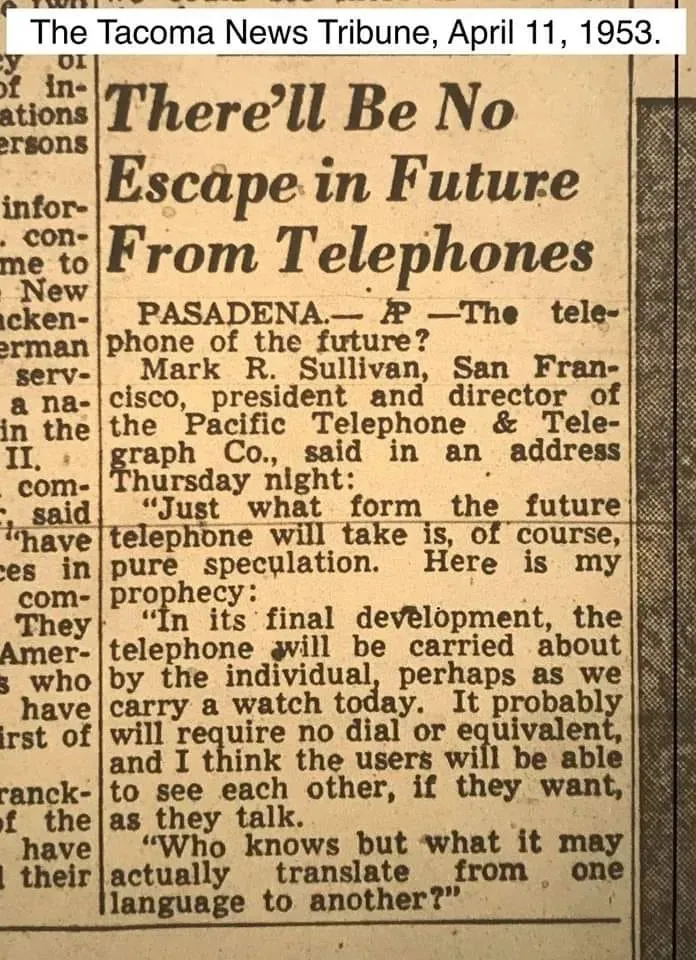The 1953 Prediction That Nailed Today’s Tech World
In 1953, a bold prediction by Pacific Telephone's CEO foresaw portable phones, video calls, and even real-time translation—decades before they became reality. Discover how this visionary statement mirrors today’s tech world—read on to unravel the eerie accuracy!
In 1953, Mark R. Sullivan, then-president of the Pacific Telephone and Telegraph Company, made predictions about the future of communication that are nothing short of jaw-dropping today. Delivered during a speech in Pasadena, California, and reported under the headline "There'll Be No Escape in Future from Telephones," Sullivan’s insights foresaw a world that looks eerily similar to 2024. Imagine a world where telephones become personal, portable, and capable of bridging not just people but cultures and languages—a world Sullivan described when most people were tethered to rotary-dial telephones.
Let’s dive into the genius behind Sullivan’s words and explore why people today find his predictions both fascinating and unsettling.
The Predictions That Hit the Bullseye

In an era when the height of communication tech was a rotary phone permanently fixed in one place, Sullivan’s predictions seemed almost science fiction. Yet his words mirrored the realities of the future so closely that they felt prophetic.
Portability
Sullivan envisioned a time when phones would no longer be anchored to walls. He suggested they would be “carried about by the individual, perhaps as we carry a watch today.”
Visual Communication
Sullivan’s speech included a bold claim: in the future, we’d “be able to see each other if we want, as we talk.” This was nearly 60 years before FaceTime became a household name.
Language Translation
Perhaps the most futuristic of Sullivan’s predictions was that phones might eventually “translate from one language to another.” This idea, while incredible in 1953, is now the reality of tools like Google Translate and real-time AI-powered translation services such as Microsoft Translator and Waverly Labs earbuds.
Why This 1953 Prediction Feels So Eerie in 2024
It’s not just the accuracy of Sullivan’s predictions that has people talking—it’s the fact that he was able to anticipate innovations so profoundly removed from his technological reality. The world in 1953 was a simpler, slower-paced time for communication:
- Phones were fixed to landlines, and phone booths dotted cityscapes.
- Video communication was a futuristic dream, only imagined in science fiction.
- Translation required human intermediaries or bulky dictionaries, with no thought of instant voice-to-voice translation.
Yet Sullivan not only predicted these changes but also grasped their social implications. His claim that there would be "no escape" from telephones resonates with 2024’s discussions around digital overload and hyper-connectivity. From screen time limits to digital detoxes, modern society grapples with the omnipresence of phones—a double-edged sword Sullivan could only hint at.
A Glimpse Into Technological Evolution
To understand why Sullivan’s predictions were so groundbreaking, let’s look at how telephony has evolved over the decades:
Mobile Phones
- 1983: Motorola’s DynaTAC 8000X, the first commercially available mobile phone, weighed 2.5 pounds and cost nearly $4,000.
- 2024: Modern smartphones weigh less than 200 grams, cost a fraction of the price, and come packed with features like AI assistants, cameras rivaling professional DSLRs, and even health-monitoring sensors.
Video Calling
- 1964: AT&T demonstrated the first video call at the World’s Fair. It was impractical, expensive, and required specialised terminals.
- 2024: With the explosion of affordable internet, platforms like FaceTime, Google Meet, and Zoom make video calls effortless. The introduction of holographic calling is just around the corner.
Language Translation
- 1990s: Early translation tools were clunky and largely limited to text.
- 2024: AI-driven translation devices now enable real-time conversations between individuals who speak entirely different languages. The rise of generative AI promises to refine this even further, breaking down global communication barriers faster than ever.
A Visionary Ahead of His Time
Mark R. Sullivan’s 1953 predictions feel less like guesses and more like a roadmap to the world we inhabit today. His foresight into portable telephony, visual communication, and translation reflects an astonishing understanding of technology’s trajectory. As we marvel at his accuracy, let’s take a page from his book and look beyond the horizon, imagining how our present-day technologies will shape the future.
In the words of Sullivan, “There’ll be no escape”—and maybe, just maybe, that’s not such a bad thing if we learn to harness the power of connectivity wisely. So, let’s hang up on doubt and call the future with confidence.
Edited by Rahul Bansal







